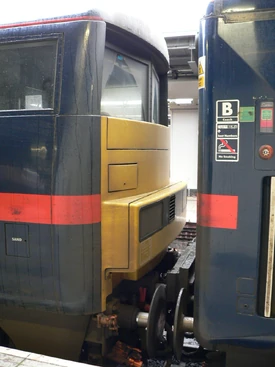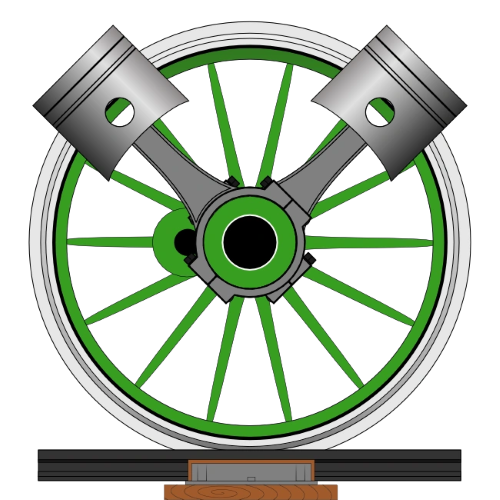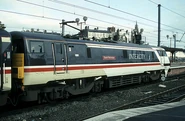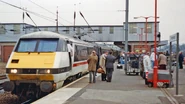The BR Class 91 ("Electra") is a class of 4 axle (Bo-Bo), 6,480 bhp electric locomotives order by British Rail and built by British Rail Engineering Limited in conjunction with GEC in 1988-1991, at their Crewe Works.

The rear of 91115 (formerly 91015).
Marketed as "Intercity 225" in reflection of their design speed of 225kph (140 mph). The other end of the Intercity 225 Trainset is A DVT (Driving Van Trailer), which has a similar body design to the Class 91 locomotive. The locomotive body and frame are of all steel construction and are praised for their crashworthiness. Traction motors are, unusually mounted inside the locomotive body connected to a bogie frame mounted geared transmission via a cardan shaft. All axles are powered. The locomotive also features an underslung transformer and rectifier leaving the body of the locomotive nearly empty. This all reduced the un-sprung mass of the locomotive reducing track damage at high speed. Most of the electrical equipment used in the Class 91 was derived from the APT-P.
History[]
In 1984-1985, with the rising cost of diesel fuel and the increase in domestic air travel, deciding to invest in the electrification of the East Coast Main Line (ECML). With electrification would come the need for a new, high speed, high power, rapid accelerating electric locomotive. In late 1984 an invitation to tender was issued to leading rolling stock manufacturers. GEC, ASEA, and Brush Traction all submitted their own designs for a 125-140 mph locomotive. In 1985 GEC was awarded the contract for detailed design of the "Electra" locomotives. British Railways also commissioned, Brush Traction to construct a single demonstrator locomotive designated Class 89. Construction was subcontracted to BREL (British Rail Engineering Limited), and construction began at Crewe Works in 1988. The design of the Class 91 was heavily influenced by experience and knowledge gained with the Advanced Passenger Train, in particular the electrical control system were directly derived as were the bogies used. Specifications called for a locomotive rated at 6480 bhp with ElectricTrain Heat\ETH so not to detract from traction. The locomotive differed from other ECML stock (InterCity 125), as it had conventional 1000vDC ETH & DropHead couplers to allow servicing stock with either Link&Hook or Janney couplers; it also draws power from 25kv50hz overhead Line Electric (OHLE) via high speed Brecknell & Willis pantographs, which has aerodynamics to ensure contact at rated speed; it was found that legacy pantographs contacted the wire only 50% of the time at highspeed.
The Class 91 was designed to have a service speed of 140 mph (225kph) however, in service the locomotives are limited to 125 mph, due to difficulty with sighting distances of the color light signals. 140 mph running was enabled for a short time after entry into service. This was done by introducing a fifth, flashing green aspect to the signals on certain parts of the East Coast Main Line to denote that the track ahead was clear for two block sections. However British Rail decided that for long-term running at 140 mph, in-cab signaling would have to be installed. Sadly, this type of signaling was not installed due to budget constraints imposed by Margaret Thatcher's Conservative Government, and speeds reverted to 125 mph with the exception of test runs.
Specs[]
- Built: 1988~1991, 31 Units = 10 ProtoTypes + 21 Production Units
- Axle\Wheel Arrangement: BoBo\4PowerAxles
- PowerRated: 6480Hp\4854 kW Via OverHeadLineElectric\OHLE.25kv50hz HiSpeedPantograph
- TracEffort: 43kLbF\190 kN Max, 24kLbF\107 kN Cont Via 4ea*1576Hp\1180 kW BodyMtd GEC.G426 Motors
- RailGage: 4f708\1m435, LoadGage: W6
- Dims: 81t5 Gross, AxleLoad\RouteAvailability 7, 63f59\19m38 LengthCoupled
- Speed: 125MpHr\201KpHr ServiceMax, 140MpHr\225KpHr DesignMax, 162MpHr\261KpHr Record
- Brake: ElecMotivForcDynamic\EMFD 83 kN 140MpHr~30MpHr, ElecPneu\EP LocoCardanShaftDisc+Tred, ElecPneu\EP Coach+DVT Disc
- Couplers: Janney\AARC\L&HD\DropHead
- Operators: BritishRail\BR, GNER, NationalExpressEastCoast, EastCoastMainLine
- Unit Numbers: 91001~91031, Later 91101~91122 & 91124~91132
The Fleet[]
When British Rail was privatized in the mid- 1990's, the Intercity Swallow livery was quickly removed from the Class 91's in favor of the dark blue with red strip color scene of private operator GNER (Great North Eastern Railway). The Class 91's operated GNER's electric services from London Kings Cross to Yorkshire and Scotland. These services included the traditional 10:00am departure from Kings Cross and Edinburgh Waverley "The Flying Scotsman". They also operated other named trains such as "The West Riding Limited", from London Kings Cross to Bradford Forster Square via Leeds. During service with GNER, on certain diagrams, the Class 91 could be expected to cover over 1,000 miles in a 16 hour shift. Heavy maintenance was undertaken at Bounds Green TMD in Alexandra Palace, North London, with minor work taking place at, Neville Hill Depot in Leeds, Heaton Depot in Newcastle, Craigentinny Depot in Edinburgh, and Polmadie Depot in Glasgow. These same depots are used today. In the mid- 2000's GNER began a major overhaul and life extension programme on the Class 91 fleet, this included replacing all electrical equipment with more modern equivalents and other reliability upgrades. This refurbishment also extended to the MK4 passenger coaches and DVT's operating with the Class 91's and included, a fully refurbished interior, new lighting systems, removal of the unused tilt mechanism form the SIG BT41 bogies, replacement of the buffet counter, fitting of new high backed seating, revised layout in all coaches doing away with the semi-compartmented layout, new pressure and sound proof door between the vestibules and the passenger areas, new toilet facilities including disables accessibly toilet in both standard and first class, extra luggage space, new paneling throughout, and power sockets at every seat. These refurbished sets were officially dubbed "Mallards", in honour of record breaking Gresley A4 Class Pacific Steam Locomotive Mallard.
When GNER lost the Intercity East Coast franchise to National Express East Coast in 2007, the red stripe along the sided of the locomotive was replaced with a white strip with the words, National Express. National Express had planned to repaint the Class 91 fleet into full National Express, silver and white livery however National Express was stripped of the franchise in 2009 having refused to provide further financial support due to lower than expected passenger numbers. The franchise along with the Class 91's passed in to the hands of the publically owned company, Directly Operated Railways under the name, East Coast Mainline Company Limited, shortened to East Coast. In June 2010, East Coast unveiled their all over silver with purple stripe livery on the Class 91's and as of 2015 all are in EC silver.
East Coast have applied special commemorative liveries to their Class 91's. These liveries include:
- 91101 was given a purple vinyl wrap and "Flying Scotsman" brand and name in May 2011. This was to mark the beginning of East Coast's accelerated, 4hr Flying Scotsman service, leaving Edinburgh Waverley at 05:40am calling at Newcastle before running non-stop to London Kings Cross arriving at 09:40am. There is now no northbound Flying Scotsman service.
- 91107 received "Skyfall" livery in 2012 in conjunction with the premier of the James Bond film of the same name.
- 91110 was painted with a Spitfire, Hurricane and Lancaster Bomber, and named "Battle of Britain Memorial Flight" in June 2012.
- 91125 was painted into Sky One HD blue livery in conjunction with, All Aboard East Coast, a documentary series following the operations and staff at East Coast Trains in November 2013.
- 91111 was unveiled in a commemorative World War One, Poppy livery and named "For The Fallen" in a ceremony at Newcastle Central on 14 October 2014.
All of these locomotives have now been repainted into East Coast silver livery but retain their names.
The Class 91 locomotives have carried various names over the years. However when GNER first took over the East Coast franchise in 1996, all locomotives were briefly nameless. However GNER started a naming programme shortly afterward with locomotives receiving cast iron nameplates. National Express removed all names from the Class 91 locomotives in 2007 and didn't replace them. However in 2009, in response to public requests, East Coast began their own naming program with the first locomotive number 91109, been named "Sir Bobby Robson" at a ceremony at Newcastle Central on March 29, the name being unveiled by Bobby Robson's widow, Elsie and footballer Alan Sheerer.
Locomotive number 91023, was involved in both the Hatfield and Great Heck, Selby Rail crashes. After these events the locomotives number was considered unlucky or cursed by GNER drivers. When the locomotive was refurbished during the "Mallard" upgrade programme, the locomotive was renumbered as 91132 instead of 91123. Since being renumbered the locomotive has not been involved in anymore serious incidents.
In November 2012, number 91114 was fitted with a second pantograph next to, but opposed to the first. This second pantograph was fitted as an experiment to increase the Class 91's resistance to pantograph and OHLE failure. The modification was conducted in conjunction with Eversholt Rail Leasing, East Coast, ESG, Wabtec Rail, and Brecknell and Willis. The second pantograph uses the same mounting points as the first but is in an opposing configuration. If there is an ADD (Automatic Drop Device) activation then the driver can raise the second pantograph and keep on going. The fitting of the second pantograph required the roof to be re-profiled with a rounder shape to the pantograph well. The auxiliary cab at the blunt end was also reconfigured to accommodate the extra electrics.
Intercity 225[]
The Intercity 225 is a train set consisting of a Class 91, up to 9 (11 planned) MK4 passenger coaches, and a MK4 DVT. The name denotes the envisioned service speed of the new trains of 225Kph (140Mph). However the trains are limited in service to 125 mph due to the lack of in-cab signaling. This continued the naming style of the Intercity 125.
Surrogate DVT's[]
During the Class 91's introduction, it was realised that the MK passenger coaches and DVT's would not be ready in time for the start of passenger services. In response several Class 43 HST powercars were converted to operate as surrogate DVT's. Numbers, 43013, 43014, 43065, 43067, 43068, 43080, 43084, and 43123 had their lower aerodynamic valences removed and fitted with conventional buffers and draw-gear and also fitted with TDM (Time Division Multiplexing) equipment to control the Class 91's. Powercars numbers 43104 and 43051 were also fitted with TMD control equipment but retained their valences and hidden emergency coupler. Also, in these latter two powercars the TDM equipment was never routed through proper jumper cables but instead was jerry rigged via a cable running through the corridor connection between the powercar and the first coach (The TC10 test vehicle). There was at least one incident of this cable being severed in a closed door causing a complete loss of brake air pressure and stopping the train.
At first the HST powercar was left with its engine idling and providing ETH to the coaches. However prolonged idling caused a build up of un-burnt fuel in the exhaust system, especially the silencers. This caused several fires and it was decided to allow the powercars to provide traction power as well as ETH. These hybrid, Electric/ Diesel Electric sets were, at the time, the most powerful trains Britain had ever seen. With both the Class 91 and the Class 43 surrogate DVT providing power, they had a total output of 8,730 bhp and could accelerate fast enough to push passenger into the backs of their seats.
After the MK4 coaches and DVT's entered service these HST powercars had the TDM equipment removed and re-entered normal HST service. However those that had been fitted with buffers still have them to this day.
British Speed Record[]
In September 1989, number 91010 (91110) attained the record speed of 162Mph at Little Bytham, near Essendine, Lincolnshire. This is the same section of the East Coast Mainline where the A4 Class steam locomotive "Mallard" set the all time steam speed record of 126.4Mph in 1938. The train was a shortened set with locomotive, 5 Mk4 coaches, and the DVT (leading). If should be noted that this speed was attained on a slight downgrade.
This record stood until 2003, when a Class 373 Eurostar e300 set attained a speed of 208 mph on section one of the High Speed 1, Channel Tunnel Rail Link. However as the Class 373 is an Electric Multiple Unit, the Class 91 remains the fastest locomotive in British History.
Accidents and Incidents[]
The Class 91 locomotives have been involved in two major and fatal accidents in their career. Both involved 91023 and were less than a year apart. These were the Hatfield rail crash, and the Great Heck (Selby) rail crash. These two incidents are also the only two major incidents to happen during GNER's tenure on the East Coast Mainline.
Hatfield Rail Crash
The Hatfield rail crash was a railway accident that occurred on 17 October 2000 at Hatfield, Hertfordshire, UK. The accident claimed the lives of four people with a further 78 people been injured. The accident resulted in infrastructure owner Railtrack, being partially renationalized, becoming Network Rail.
A GNER InterCity 225 train bound for Leeds had left London King's Cross at 12:10, and was travelling at approximately 115 miles per hour (185 km/h) when it derailed south of Hatfield station at 12:23. The primary cause of the accident was later determined to be the left-hand rail fracturing as the train passed over it. Four passengers died in the accident and a further seventy were injured.
The leading Class 91 locomotive (91023) and the first two coaches remained upright and on the rails. All of the following coaches, and the trailing Driving Van Trailer were derailed, and the train set separated into three sections. The restaurant coach, the eighth vehicle in the set, overturned onto its side and struck an overhead line gantry after derailing, and was catapulted into the air before landing again, resulting in severe damage to the vehicle.
Those who died were all in the restaurant coach:
- Robert James Alcorn, 37 of Auckland, New Zealand.
- Steve Arthur, 46 from Pease Pottage, West Sussex.
- Leslie Gray, 43 from Tuxford, Nottinghamshire.
- Peter Monkhouse, 50 from Headingley, Leeds.
Crash investigators identified the integrity and strength of the British Rail-designed Mark 4 coaches for protecting occupants. Coincidentally, the locomotive in the crash was also involved in the Great Heck rail crash (where the leading Driving Van Trailer hit a road vehicle on the track) a few months later.
After the crash, A memorial garden to the dead, was opened adjacent to the accident site in Hatfield.
Great Heck (Selby Rail Crash)
The Great Heck rail crash, widely known as the Selby rail crash, was a high-speed train accident that occurred at Great Heck near Selby, North Yorkshire, England on the morning of 28 February 2001. Ten people died, including the drivers of both trains involved, and 82 people suffered serious injuries. It remains the worst rail disaster in the 21st century in the United Kingdom.
The crash occurred at approximately 06:13 (GMT), when a Land Rover Defender towing a loaded trailer (carrying a Renault Savanna estate car) swerved off the M62 motorway just before a bridge over the East Coast Main Line. The vehicle ran down an embankment and onto the southbound railway track. The Land Rover's driver, Gary Neil Hart, tried to reverse it off the track, but he could not. While he was using a mobile telephone to call the emergency services after exiting the vehicle, the Land Rover was hit by a southbound GNER InterCity 225 heading from Newcastle to London King's Cross.
The InterCity 225 was propelled by a Class 91 locomotive (No.91023) and led by a Driving Van Trailer (DVT). After striking the Land Rover, the leading bogie of the DVT derailed but the train stayed upright. Points to nearby sidings then deflected it into the path of an oncoming Freightliner freight train carrying coal and travelling from Immingham to Ferrybridge hauled by an EMD Class 66 locomotive (No.66521). The freight train hit the wreckage approximately half a mile (642 metres) from the passenger train's impact with the Land Rover. The impact resulted in the near destruction of the lightweight DVT and severe to moderate damage to all nine of the InterCity 225's coaches, which mostly overturned and came to rest down an embankment to the east side of the track, in the gardens of local residents. The trailing locomotive remained upright and suffered minor damage, although it was derailed. The Class 66 freight lost its bogies after impact, with debris of the DVT jammed underneath rupturing its fuel tank. The freight locomotive then overturned onto its left side, sustaining major damage to its cab area and right side. The first nine wagons following it were also derailed and damaged to varying extents.
Immediately before the impact of the two trains, the speed of the InterCity 225 was estimated as 88 mph (142 km/h) and that of the freight train as 54 mph (87 km/h). With an estimated closing speed of 142 mph (229 km/h), the collision between the trains is the highest speed railway incident that has occurred in the UK.
Replacement[]
The finalized £4.5 billion contract for trains for the Great Western Main Line and East Coast Main Line (ECML) was announced in July 2012. Capital costs for the vehicles are approximately £2.8 million per carriage for bi-mode versions and £2.4 million per carriage for electric versions. Financial closure was reached on the first phase of the contract, valued at £2.4bn, consisting of 21 nine-car electric (Class 801) and 36 five-car bi-mode trains (Class 800), 369 carriages total, for use on Great Western routes.
The second phase of the contract consisted of 10 five-car and 13 nine-car bi-mode and 12 five-car electric units (227 carriages) for use on the ECML; financial closure on the second phase was expected in 2013. A £1.2bn option for further 30 nine-car electric trains (270 carriages) to replace the Intercity 225 on the ECML was taken up on 18 July 2013.
Gallery[]
References[]
- Book: The Complete Book of Locomotives by Colin Garratt, published by Hermes House. ISBN: 978-1-84477-022-9.
- Rail.co.uk
- Wikipedia.org







